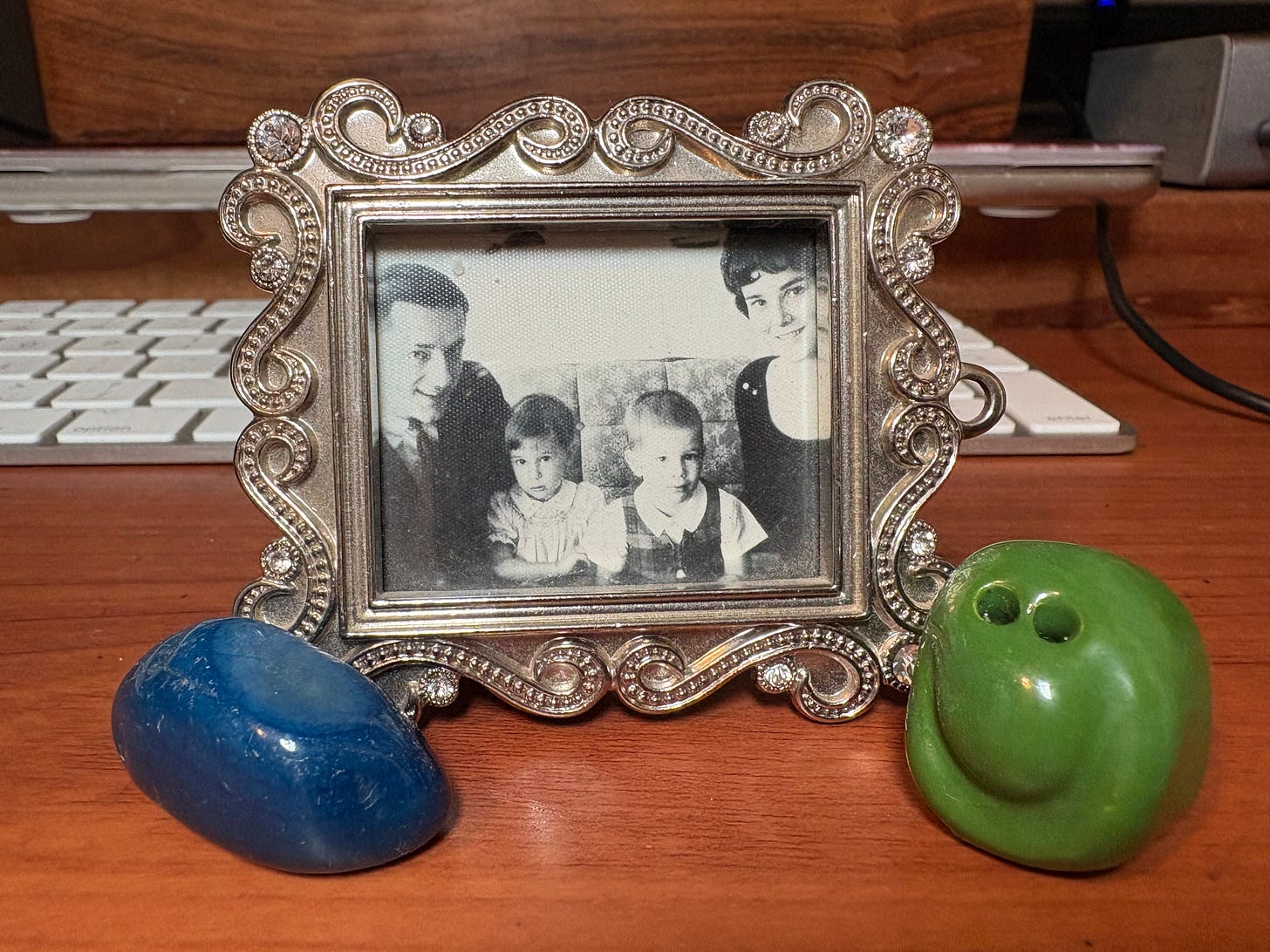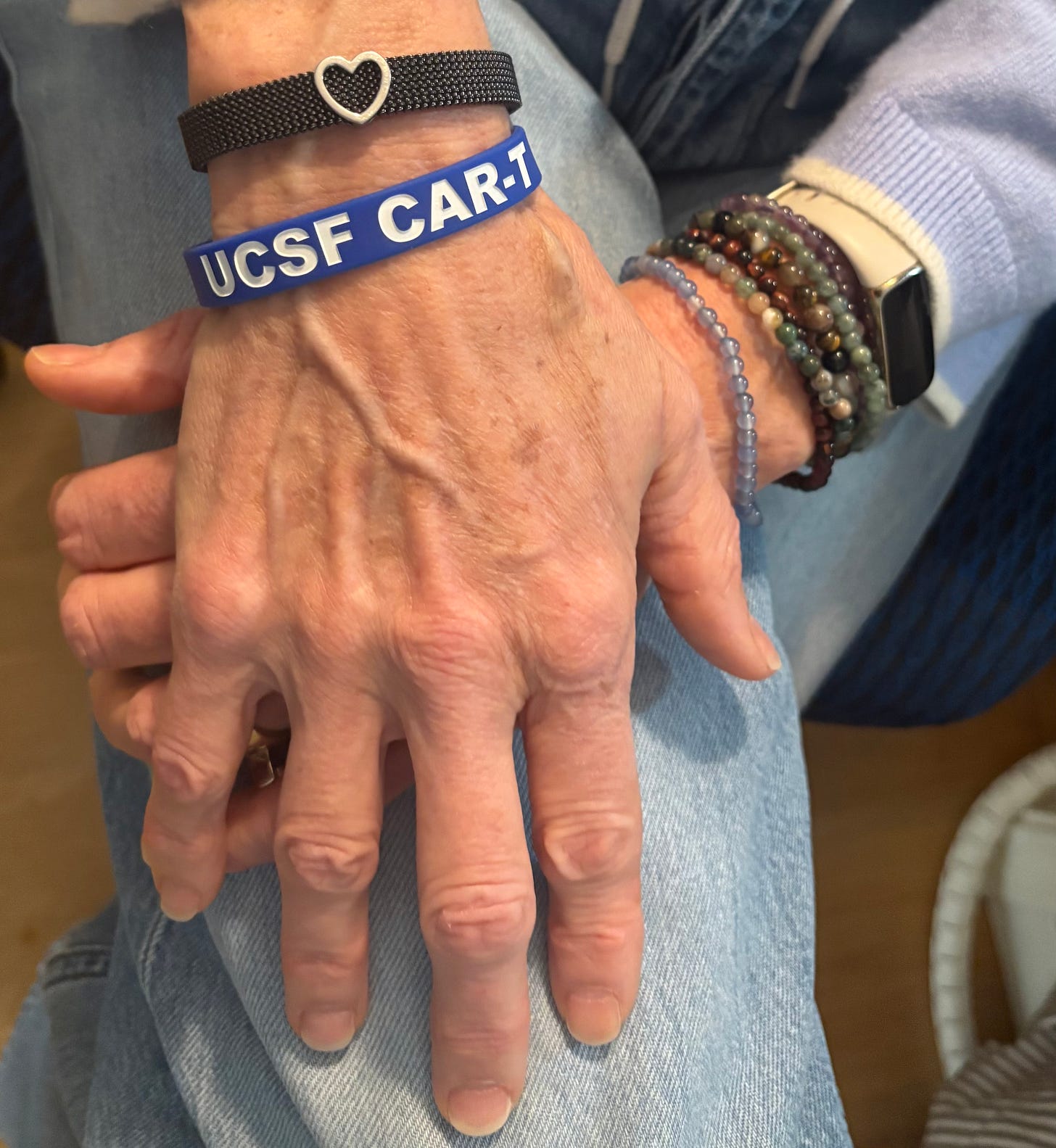There are three objects on my desk. No one but me knows why they're there.
One is a shiny royal blue stone. I have no idea what kind of stone it is or how it got so smooth and polished. A tumbler, maybe? But I remember exactly where I found it.
We were attending a friend’s son’s wedding in Mendocino County. I was wading with the dogs, Lucy and Leo, in a quiet tributary of the Pacific. It was a luminous summer afternoon. The sky was pastel blue. It was warm, but not hot—just right. My husband was there, but at a distance. He was often at a distance.
I stood in the sharply cold water, sand beneath my feet, fully in my body. Like my dogs, I was taken by the sensory experience while looking around for shells or signs or life. Aren’t dogs always taken by the sensory experience and always in search of something?
I looked down at my red feet, and there it was: a bright blue stone, hiding in plain sight, but not hiding at all—beckoning, really. I picked it up and held it in my palm. Where did you come from, little stone? How did you find your way here?
These days, I hold this little stone in my palm when I’m coaching a client. When I have the urge to jump in, to fix, to find a shortcut. The stone says, wait, just be here and see what comes. Be in the mystery.
The second item is a small, green, glazed piece of clay with a smiley face etched on it. My friend, Elizabeth, gave it to me after I told her about my cancer diagnosis. It was made by a sculptor or ceramicist. He saw opportunity in the artist’s waste, and turned what might’ve been discarded into something silly, meant to bring a smile. It reminds me to look for the possibilities, and that joy is always within my grasp. Even when things are very, very hard.
The third is a tiny black-and-white photograph in an ornate silver frame. It's an image of my father, my mother, my brother, and me, sitting on the living room sofa in our first home in Boylston, MA. I’m about two years old. We’re all dressed in our Sunday best.
I have a pixie haircut and am in a smocked dress with a peter pan collar and short, puffy sleeves. I’m wearing a somber expression, somewhere between worried and sad. I’m snug up against my father while my right hand is almost touching my brother.
The image captures something of my essence. That sensitive child still lives in me. She deserves protection. Whenever I gaze at it, as I often do, I remember to be kind to myself.
In coach training, I learned about structures—physical objects that act as sentinels, guarding our values and reminding us of what matters—private totems that tether us to meaning.
I’ve returned to my desk and am working with clients again. I feel like I’ve been gone for a long time. It’s disorienting. Some days, my office feels like a dream—familiar and not familiar, mine and not mine. I am re-engaging, but almost like a stranger. I look around for something to anchor me. Structures.
I actually have lots of structures, many of which helped hold me together for the past four and a half years.
In the months after I received the diagnosis, my word search puzzle book (which I wrote about here) was a structure I carried to every clinic visit. It made it easier to escape, to not engage. I didn’t need it for long—maybe a year—but I needed it fiercely in the beginning.
During hospital admissions, I always brought my own pajamas and day clothes. Only now do I see them for what they were: structures. They reminded me that I was more than a room number, a birthdate, an ID band. I was a woman with an identity. Wearing my own clothes let me say it without words.
During the grueling three-week stem cell transplant hospital stay, I taped a wall of photos near my bed, a structure to remind me I wasn’t alone.
On my left wrist, I wear a stack of beaded bracelets that I’ve collected over the past four years. Each bracelet is made of a different stone, and each stone is said to carry a metaphysical property, such as courage, resilience, protection.
I wear these bracelets every day and think of them as a forcefield, protecting me and healing me. I don’t know if anything has that kind of power, but I like to think it’s possible.
On my right wrist, I wear a stretchy silver Tiffany band with a small heart charm—a Mother's Day gift from my husband many years ago. It reminds me that I am part of a family. Woven into them, as they are woven into me.
In the bedroom, more structures. The soft, ivory chunky knit heart pillow my childhood friend Denise sent me around the time of my stem cell transplant. On bad days I clutch it to my chest and remember the thread that still ties me to cherished friends, even ones I haven’t seen in a lifetime.
A framed photo sits on the shelf next to the bed. It was taken during a fundraising hike I took in Alaska with a group of myeloma patients, friends, family members, filmmakers, and doctors. We raised money, walked, talked, and connected. And we climbed. That photo now gets my ass out of bed in the morning, reminding me of my resilience and the strength I draw from others.
My home is full of these structures. Inherited art. Art made by loved ones, including my children. Art acquired on our travels. They are totems of what has mattered; what still does.
And here at my desk sit my three little structures - a stone, a smiley face, and that precious family photo. They silently guard the mystery, the possibilities, the joy, and the child. My anchors.
What helps you remember what matters? Do you have a structure? If not, you might give it a try. Think of one of your most important values, or some habit you are trying to break or embrace. What object would help remind you of that value or commitment?
I’d love to hear about it.






